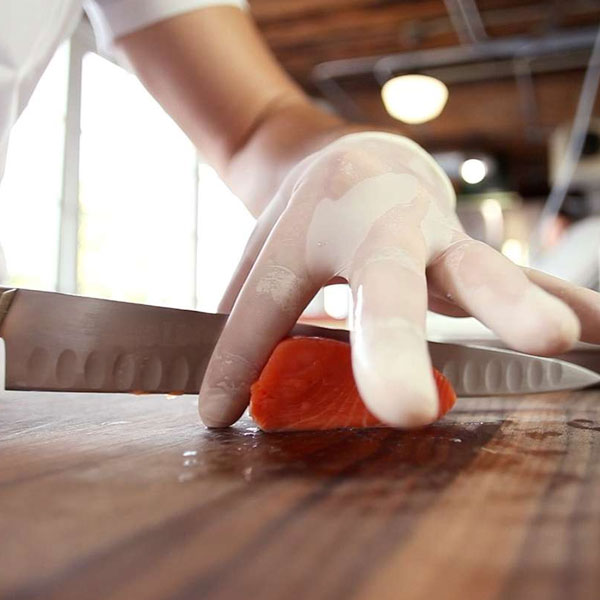
Food safety in the kitchen is essential. Cross-contamination can quickly occur if proper hygiene isn’t followed, especially when using knives. Knives touch various foods—raw meats, vegetables, and ready-to-eat items. If not properly cleaned, these knives can spread bacteria, leading to foodborne illnesses. Understanding when and how to clean knives is a key part of kitchen safety.
This article breaks down the essential moments for cleaning and sanitizing knives and provides practical steps to maintain a safe cooking environment.
Why is Cleaning and Sanitizing Your Knife Essential?
Food safety is directly linked to the cleanliness of kitchen tools, especially knives. Cross-contamination happens when harmful bacteria transfer from one food item to another through a dirty knife. Raw meats, vegetables, and other foods can carry bacteria like Salmonella or E. coli. When a knife touches these foods, it can harbor these bacteria.
If you don’t clean the knife properly, bacteria can easily transfer to other foods, posing a risk of foodborne illness. Therefore, a simple wipe with a cloth is not enough; knives need thorough cleaning and sanitizing.
When Must You Clean and Sanitize Your Knife

1. Switching Between Different Types of Food
A knife must be cleaned and sanitized immediately after cutting raw meats, poultry, or fish and switching to other food types like vegetables or cooked items. Raw meats contain harmful bacteria that can transfer to fresh or ready-to-eat foods, causing cross-contamination. For instance, if you chop raw chicken and then slice vegetables for a salad with the same knife, you risk spreading bacteria.

2. After Cutting Raw Foods
Cleaning and sanitizing a knife after handling raw foods is not optional; it’s mandatory. Raw foods, particularly meats and poultry, carry bacteria that can cling to knife surfaces. Even if it doesn’t appear dirty, the knife may still harbor invisible bacteria. Therefore, always clean and sanitize it before using it on foods like bread, fruits, or cooked meats.

3. When Switching Between Different Types of Raw Meat
Different types of raw meat (such as chicken, beef, or seafood) may carry various bacteria strains. Switching between these without cleaning your knife could spread bacteria specific to each meat. To minimize this risk, clean and sanitize the knife each time you switch between different meats.

5. After Cutting Juicy Foods
Some foods, like fruits and vegetables with high water content, release juices that can carry bacteria. When you chop these items, juices can coat the knife and become a breeding ground for bacteria. Hence, knives should be cleaned and sanitized after cutting foods that produce a lot of juice.

6. When the Knife Contacts Non-Food Surfaces
A knife might accidentally touch surfaces like the floor, sink, or countertop. These areas can host bacteria, which could transfer to the knife and eventually to food. If this happens, it’s crucial to clean and sanitize the knife before using it again.

7. At Regular Intervals During Food Prep
If you’re involved in a lengthy cooking session, clean and sanitize knives periodically, even if they’re being used on the same type of food. Bacteria can build up over time, especially when cutting raw items. Frequent cleaning reduces the risk of contamination.
How to Properly Clean and Sanitize a Knife

Step 1: Clean First
Begin by washing the knife with warm, soapy water. This step removes food particles and some bacteria from the knife’s surface. Make sure to scrub the blade, handle, and any crevices where food particles might be trapped. Use a dish brush or sponge, and wash the knife thoroughly under running water. For best results, use a kitchen towel to wipe it dry before sanitizing. Remember, this process eliminates visible dirt and some germs but doesn’t kill all bacteria.

Step 2: Sanitize
Sanitizing goes beyond cleaning. After washing, prepare a sanitizing solution by mixing one tablespoon of unscented chlorine bleach with a gallon of water. Submerge the knife in the solution for at least one minute. Alternatively, use commercial sanitizing sprays or wipes made specifically for kitchen tools. Make sure to read the label for proper use and contact time. Sanitizing kills bacteria that simple cleaning might not eliminate, ensuring the knife is safe for its next use.

Step 3: Dry Properly
Proper drying is just as important as cleaning and sanitizing. Air drying is the most hygienic option as it prevents recontamination from towels. If you use a towel, ensure it is clean and dry. Avoid stacking wet knives, as moisture creates a favorable environment for bacterial growth. Store the knife in a clean, dry place to keep it safe for future use.
6 Common Mistakes to Avoid While Cleaning and Sanitizing Your Knife
When it comes to cleaning and sanitizing knives, some common errors can compromise food safety. These mistakes often occur because of misconceptions about cleanliness or simply due to lack of awareness. Let’s go over a few pitfalls to avoid for a safer kitchen environment.
1. Using Harsh Chemicals
One of the most frequent mistakes is using harsh chemicals to clean your knives. These chemicals can harm your knife’s blade and handle. You should opt for mild dish soap and warm water instead to prevent damage. This ensures the knife stays clean without compromising its durability or sharpness, protecting both the blade and handle from unnecessary wear.
2. Wiping the Knife with a Cloth Instead of Properly Washing
A quick wipe with a cloth might seem like an easy fix, but it doesn’t thoroughly clean the knife. In fact, wiping can spread bacteria rather than remove it. Proper washing with warm, soapy water, followed by sanitizing, is necessary to ensure the knife is free of contaminants. Avoid using dirty or damp kitchen towels, as they can introduce more bacteria to the knife.
3. Soaking in Water
Soaking a knife in water, especially one with a wooden handle, can cause rust on the blade and swelling of the handle. This weakens the knife over time and shortens its lifespan. Instead, always hand wash your knife immediately after use and dry it thoroughly to maintain its quality and durability.
4. Using a Dishwasher
Using a dishwasher for cleaning knives can cause significant damage due to the intense heat and water pressure. The motion can dull the blade, and prolonged exposure to moisture may lead to rust. Hand washing with mild soap and drying immediately is the best way to preserve a knife’s sharpness and longevity.
5. Not Sanitizing Properly
Cleaning only removes dirt, while sanitizing eliminates bacteria that could linger on the knife. To properly sanitize, mix 1 tablespoon of bleach with 1 gallon of water. After cleaning, dip the knife in the solution for added protection. This ensures a safer, more hygienic tool for food preparation.
6. Storing Before Drying
You should not store your knife before it’s fully dry as it can lead to trapped moisture, which causes rust and dulls the blade over time. To prevent this, always ensure the knife is completely dry by air drying or towel drying it thoroughly before putting it away, preserving both its sharpness and durability.
Frequently Asked Questions
1. How Often Should Knives be Cleaned During Food Preparation?
Knives should be cleaned after every use, especially when switching between different foods, like raw meat and vegetables.
2. Can I Just Wipe the Knife Instead of Washing it?
No, wiping doesn’t remove bacteria. Proper washing with warm, soapy water followed by sanitizing is necessary.
3. What’s the Difference Between Cleaning and Sanitizing?
Cleaning removes visible dirt and some bacteria. Sanitizing kills the remaining bacteria, making the knife safe to use.
4. Can I Use the Same Knife for Raw Meat and Cooked Food?
No, using the same knife without cleaning and sanitizing it first can cause cross-contamination, leading to foodborne illnesses.
5. How Do I Sanitize a Knife Without Using Bleach?
You can use commercial sanitizing sprays or wipes designed for kitchen tools. Alternatively, use hot water (at least 170°F) to sanitize.
Wrapping Up
Maintaining knife cleanliness is crucial for food safety in your kitchen. Cleaning and sanitizing after every use, especially when switching between foods, minimizes cross-contamination risks. Proper washing with soap, sanitizing, and drying keeps harmful bacteria at bay. Avoid common mistakes like wiping the knife or ignoring contact with non-food surfaces.
Implementing these habits in your daily cooking routine ensures a safer kitchen environment and reduces the chance of foodborne illness. A few extra steps go a long way in keeping food preparation safe and healthy.







